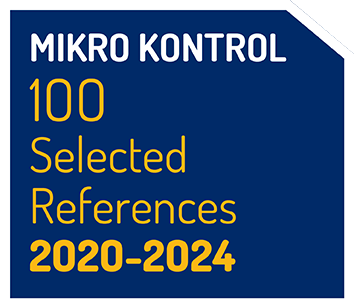References by Industries
Mikro Kontrol has a proven track record in delivering a wide range of engineering projects across various industries, including mining, metallurgy, power, chemicals, water and wastewater, food and beverage, oil & gas, crane systems, mechatronics, and more. Our projects vary in both size and complexity — with some extending beyond automation to include the installation of medium-voltage systems up to 35 kV, as well as the supervision of mechanical works on site.
Mikro Kontrol is committed to delivering high-quality solutions on every project.
No exceptions.
Selected References in
Mining
We successfully accomplished over 70 automation projects in mining. They vary in size and some of them even surpass the scope of automation, by including installation of MV up to 35kV, and supervision of mechanical works on field.
WE PRESENT SOME OF OUR LARGEST PROJECTS BELOW
Complete Electrical Works on Bucket Wheel Excavator 6600, ThyssenKrupp Industrial Solutions
To increase the coal production capacity, Mikro Kontrol realized the complete electrical engineering, turnkey solution, for the whole Bucket Wheel Excavator, as a part of a new (VI) ECS system of the open-pit coal mine Drmno (Thermo-electric Power Plant Kostolac). The installed electrical power is 7,23MVA, voltage level is 6kV.
Mikro Kontrol provided detailed and as-built design, E-houses and cabinets assembly, FATs, application software, whole electrical works, site supervision, as well as commissioning.
- State-of-the-art equipment and solution
- Done within 24 months
- Maximum level of reliability and availability
- Operation and maintenance convenience
- Integration into supervising and control system for the ECS system and the whole opencast mine
Technical Description
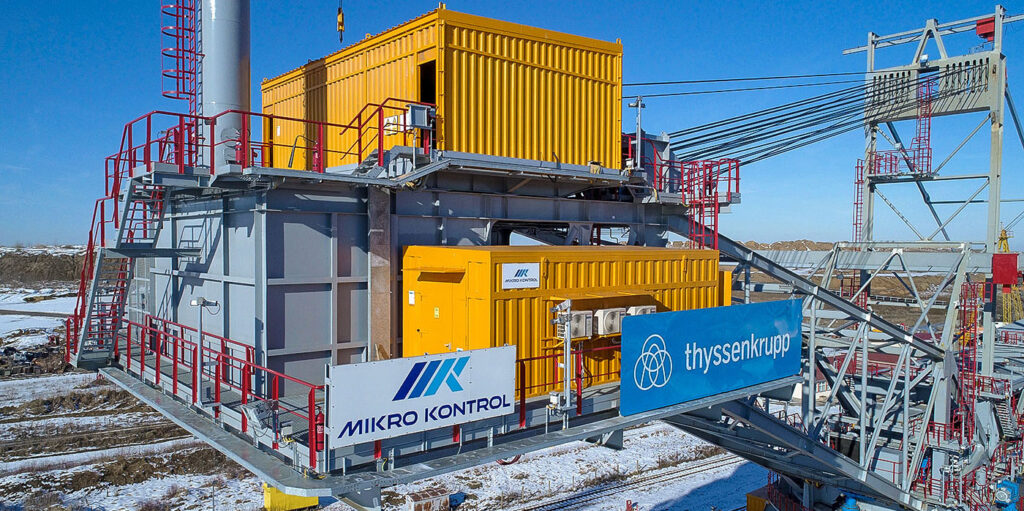
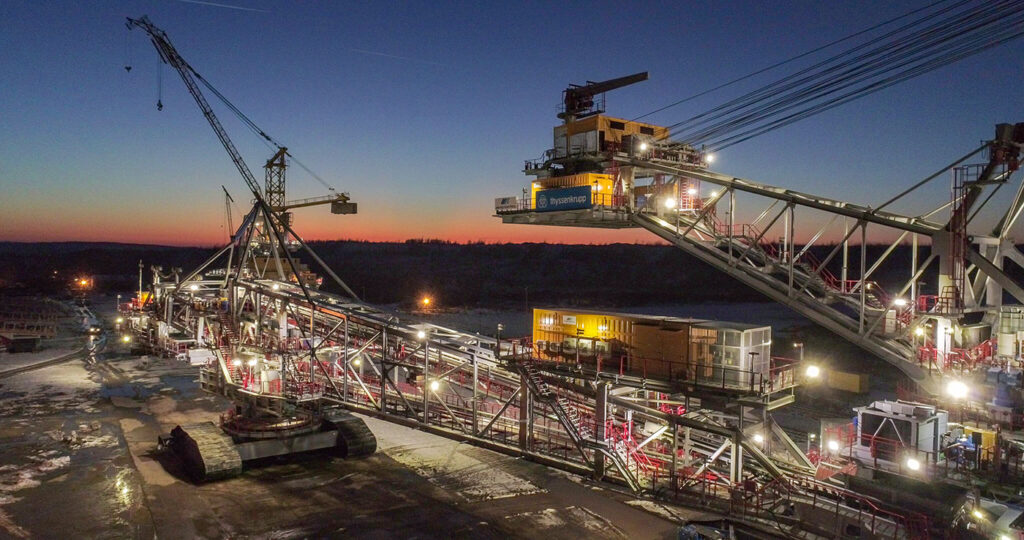
Complete Electrical Works on Spreader 8 800, Sandvik
To increase the coal production capacity, Mikro Kontrol realized the full electrical engineering, turnkey solution, for the whole Spreader, as a part of a new ECS system. The installed electrical power is 5,6MVA, voltage level is 35kV.
Mikro Kontrol provided detailed and as-built design, E-houses and cabinets assembly, FATs, application software, whole electrical works, site supervision, as well as commissioning and trial operation.
- State-of-the-art equipment and solution
- The first machine on site as an environmental improvement project
- Done within 24 months
- Maximum level of reliability and availability
- Operation and maintenance convenience
- Integration into supervising and control system for the ECS system and the whole opencast mine
Technical Description
Electrical Equipment Revitalization of 2 ECS Systems, Gacko Open Pit Mine
The project included the reconstruction and replacement of electrical equipment on 20 machines, 30 years old, which are parts of two ECS systems (Excavator – Conveyer -Spreader) within RiTE Gacko (mine and power plant Gacko).
Mikro Kontrol provided detailed and as-built electrical design, delivery of low-voltage and control cubicles, motors and frequency converters, application software, commissioning, and training.
- Providing further smooth system operation
- Maintenance optimization of the production capacity
- State-of-the-art equipment and solution
- Increased level of reliability and availability
Technical Description
- 3 Bucket Wheel Excavators
- 2 Loading Units-Transporters
- 3 Spreaders
- 12 Rubber Belt Conveyors
Refurbishment of 17 Mining Machines Damaged in Floods, Kolubara Open Pit Mine
In the heavy floods that have happened in Kolubara basin, many mining machines were damaged. Mikro Kontrol did the refurbishment of complete electrical system for 17 mining machines.
Scope of Work
Mikro Kontrol provided detailed and as-built design, electrical equipment assembling and delivery, site supervision, test and commissioning for the following units: two Mobile Shifting Devices, ten Drive Station for Conveyors, two Belt Wagons, one Bucket Wheel Excavator, one Spreader, and two Dispatching Centers.
Benefits
- Open pit mine put into operation after catastrophic damage
- Done within less than two years
- Electrical equipment refurbished and modernized
- State-of-the-art equipment and solution
Technical Description
The basic concept applied to all machines is as follows:
- Supply voltage 6kV
- 6 kV power cable with integrated optic fibers
- SF6 medium voltage switchgears
- Converter-Duty Power transformers, designed for harsh environment and operation in mine
- Motor drives with variable speed control on voltage 690V
- Multi Drive VFD configuration for machines and Single Drive VFD configuration for conveyors
- Decentralized PLC configuration
- Control, monitoring and visualization via HMI and SCADA
- Ring structure of the fiber optic network
- PROFIBUS and PROFINET protocols
Complete Electrical Works on Bucket Wheel Staker Recliner, FAM-CMEC
Mikro Kontrol, as a subcontractor of CMEC, provided full electrical work for BWSR.
The machine is intended for supplying coal to the new Block B3 of the Kostolac B Thermal Power Plant. The combined machine consists of the main machine and a sliding carriage. It is designed for stacking, reclaiming, transloading, and combined operation of bulk materials in landfills.
Scope of work: detailed and As-built electrical design, engineering, assembly, delivery, and installation of electrical cabinets, development of PLC and HMI application software, FAT (Factory Acceptance Testing), site supervision, commissioning, training, and trial operation.
Technical description:
The combined machine, BWSR, consists of the main machine and a traveling carriage. The machine is designed for stacking, reclaiming, transferring, and combined transfer + reclaiming operation of bulk material in open-air stockyards. The machine travels on rails at a variable speed. The upper structure can also rotate at variable speed. The boom of the bucket wheel can be raised and lowered.
The Reclaimer / Stacker is delivered with a power cable intended to be connected to a 6kV grid. The installed power of the Stacker is 730 kVA.
The connection of frequency converters and other equipment with safety functions to the PLC is realized using the PROFIsafe profile over a PROFINET network.
Machine control is performed using a Siemens PLC S7 CPU 1516F-3 PN/DP located in the PLC cabinet inside the E-container on the traveling carriage.
The most modern solutions and equipment have been applied to ensure maximum reliability, as well as comfortable and facilitated operation for both the operator and maintenance staff.
Complete Electrical System for a Portal Bridge Stacker, Dobersek Engineering, Uchquduq, Uzbekistan
Mikro Kontrol delivered complete electrical system for a Portal Bridge Stacker for gold sludge in Hydrometallurgical Plant 3 (GMZ-3) of the Navoi Mining and Metallurgical Plant, Uzbekistan.
Scope of Work
Mikro Kontrol provided detailed and as-built design, electrical equipment assembling and delivery, installation materials delivery, site supervision, test and commissioning.
Benefits
- Turn-Key solution
- State-of-the-art equipment
- Advanced drive and software solutions against bridge misalignment
- Maximum level of reliability and availability
- Operation and maintenance convenience
Technical Description
The main power supply 380V, 50Hz is realized over festoon system. The power supply for movable spreader conveyor and its travel drives are realized as sub-distribution over festoon system as well. The main MCC and PLC are located on the bridge itself.
Bridge Drives and Spreader Conveyor Travel Drives are designed as Variable Frequency Drives. The bridge drives are operating synchronously in load-sharing master-slave operating mode. There is a multi-turn absolute encoder to measure travel and a reference marker on the both sides of the bridge.
PLC software is tracking parameters and making corrections against Bridge misalignment. Operator desk with HMI touch panel, operator joysticks and signaling and control elements is in operator room next to the stockyard. Communication between control elements is realized over Profinet communication.
All the used components and materials are designed for harsh environment and operation in mine.
Complete Electrical System on New Stockyard on the OCM Tamnava, FAM Magdeburg
As a part of the project for Coal Quality Management System (CQMS) for a new Stockyard and Crusher Plant on the OCM Tamnava, Mikro Kontrol as a subcontractor of FAM Magdeburg, did the equipment procurement and installation on field.
Scope of Work
Mikro Kontrol provided basic, detailed and as-built electrical design, delivery and installation of VFDs for a new Crushers, hardware expansion of existing DCS system in existing Crushing Plant, software programming, upgrading and integration of existing DCS system in new CQMS, electrical mounting of new stockyard machines and crushers, as well as the commissioning services.
Benefits
- Coal deposit homogenization
- Increased deposit utilization
- Increased energy efficiency
- Reduced negative effects of environment exploitation
- State-of-the-art equipment and solution
- Maximum level of reliability and availability
- Operation and maintenance convenience
Technical Description
New Stockyard for crushed coal on the OCM Tamnava is used for coal homogenization. It includes 18 belt conveyors, 4 crushers, stacker and 2 reclaimers.
MV & LV switchgears supply the whole equipment.
In order to fully integrate the existing DCS system of Tamnava Crushing Plant into the new CQMS, it was expanded with the new network nodes and upgraded to CEMAT, add-on library for Siemens PCS 7.
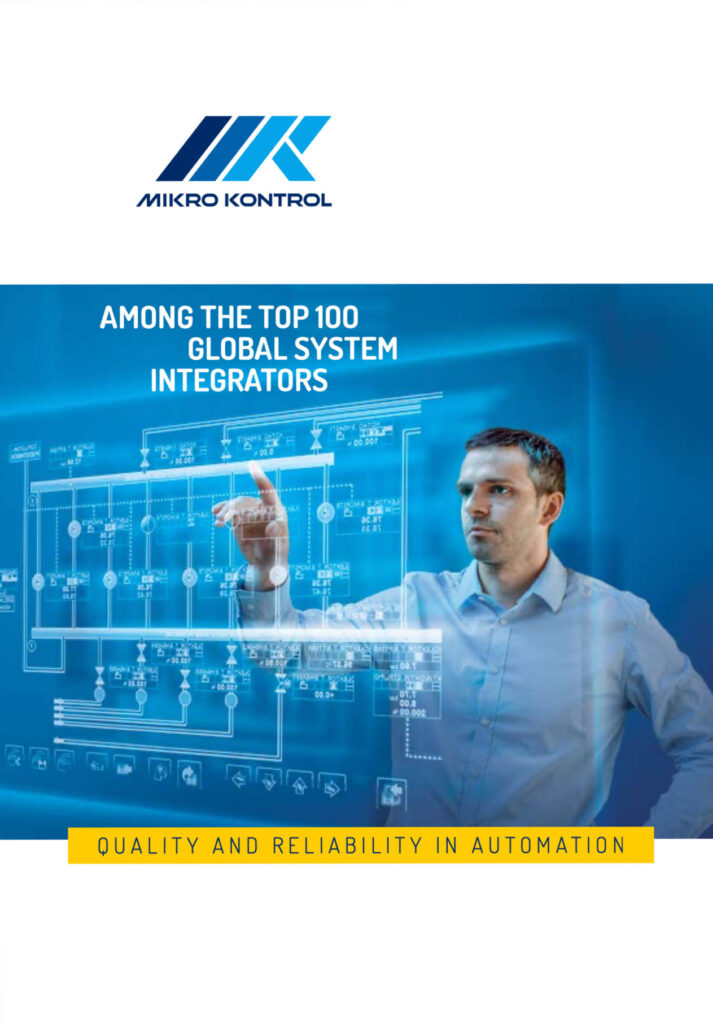
Mikro Kontrol Catalogue
Download our company profile and catalogues by clicking the links below.
Selected References in
Metallurgy
WE PRESENT SOME OF OUR LARGEST PROJECTS BELOW
Automation of Copper Anode Weighing and Casting System, Bor Copper Mine
- State-of-the Art equipment and solution; the old machine was out of work for several years
- Increasing production capacity and product quality
- Maximum level of reliability and availability
- Operation and maintenance convenience
- The whole project is done within 6 months. It’s successful realization encourages customer to plan the modernization of the second casting machine.
Automation of Copper Concentrate and Coil Conveying System, Bor Copper Mine
We did complete refurbishment and modernization of the copper concentrate and coil conveying system, which transport material from loading units (train wagons, trucks or conveyor system from the filtration plant) towards the Flash Furnace, the Converter bunkers or to the Reactor 200t bunker.
Scope of Work
Mikro Kontrol provided detailed and as-built design (DCS, MCC, network), DCS panel manufacturing, application software, supervision of the electrical works at the site, as well as testing and commissioning.
Benefits
- Decentralized Control System (DCS) equipment and solution
- Done within 6 months
- Maximum level of reliability and availability (24h/7 day)
- Operation and maintenance convenience
Technical Description
The conveying system consists of 105 motor drives. Old control system is completely refurbished using new Local Control (LC) panels placed at the conveyor’s location, cabling, and motor control cabinets (MCC).
The MCCs are withdrawable, where each unit consists of power supply part and motor starters, connected to DCS via fieldbus. LC panels collect all peripheral sensor signals, and transfer them to the DCS (command voltage 110 VAC)
The DCS of the conveying system is realized with a redundant PLC and distributed I/O units, motor starters as the field equipment, and redundant SCADA servers. A redundant structure provides high reliability for the whole control system. In the case of failure, an uninterruptible power supply (UPS) is installed to provide a proper shut down of the control system.
Blast Furnace Control System, Copper Mill Sevojno
- Improved maintenance and adjustment of process parameters
- Maximum level of reliability and availability
- Very fast detection of errors in the system
- Easy and Efficient Maintenance
- Starts the aeration blower, checks the gas barrier, switches on zones of the furnace in defined order
- Checks and stops in case some of the relevant signals for furnace normal operating is not in regular range (pressure relief valve, gas pressostat, wire transporter’s swinging movement photo-cells,..)
- Locally operated from touch terminal
- Switches on individual zone burners , manual or automatic preserves wire burning zones temperature
- Records and displays temperature signals on the terminal
- Displays alarm states
Control and Supervising System of Technological Converter Line No. 3, US Steel Serbia Smederevo
- High operation reliability in extremely hard industrial conditions
- User-friendly operator’s interface
- Safer and more accurate monitoring that leads to immediate detection of problems
- Shortened production delay
Control and Supervising System of Iron Ore Sintering Line No. 4, US Steel
During sintering process the iron ores are thermally treated; the carbonate, sulfide and oxide molecules are dissociated, with the final goal to provide a “self-melted” sinter material which is smelted easily at the Blast furnace plant. Environmental protection is very important issue, therefor the control of Electric precipitators with dust conveying is realized within the project scope.
Scope of Work
Mikro Kontrol provided detailed and as-built design, application software, MCC and control panel manufacturing and install, electrical works at the site (dismantling the old control system – panels and cabling, mounting of electric equipment as well as sensors and actuators), testing and commissioning.
Benefits
- State-of-the Art Control System equipment and solution
- well-tuned process parameters
- operation and maintenance convenience
- done within 6 months
Technical Description
The control and monitoring scope involves manufacturing, installing and connection of 11 MCC / control panels, 2 operator pulpits and 70 local control cabinets; replacing of 6 DC motor drives (drum feeder, sinter machine and line cooler) with AC motors (frequency control drives); design, delivery and mounting of two weigh scales 200t/h, 80 process sensors (pressure, flow, temperature and moisture); control of MV fan (two speed, 6kV / 1000kW, DC drive); electrical erection – more than 25km of cable trays and cables – signal and power.
Control system is realized with decentralized architecture where master PLC communicates over fieldbus with 8 decentralized I/O nodes, including decentralized periphery at electric precipitation location as intelligent slave (autonomous PLC).
Complete electrical work on mobile conveyors H3a and H4a, HBIS
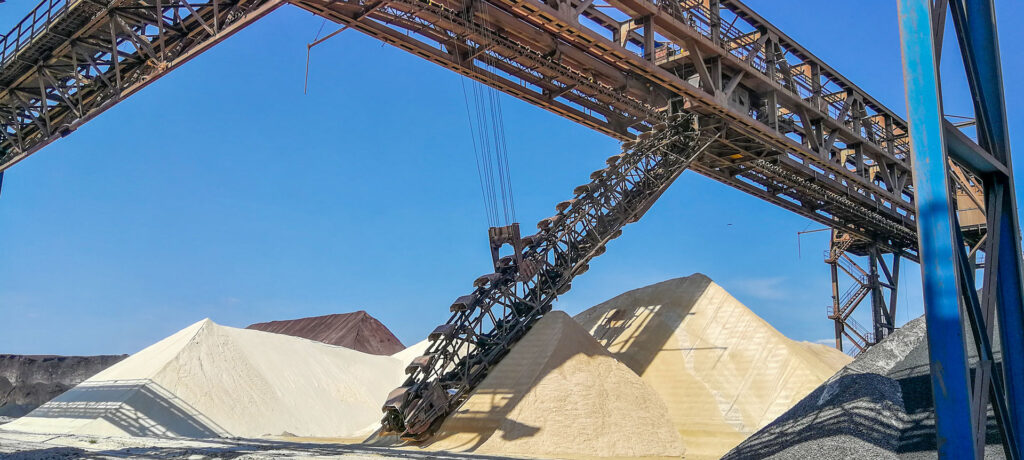
Technical Description
The 400V power supply to the low voltage conveyor cabinets is derived from the local H3 and H4 conveyor cabinets and is located on the platform below the conveyor.
The whole electrical equipment is placed in electrical cabinets and is made in relay technology. The local control cabinets are located on a platform near the conveyor to allow the operator a detailed overview and information about the state of the conveyor and the material flow.
The belt conveyor motor and the transport conveyor are controlled by a direct online method with protection functions via the protection relays and sensors on the conveyors.
To increase the safety transport of agglomerates of HBIS ironworks in Smederevo, Mikro Kontrol delivered a turnkey project of mobile conveyors, which includes complete electrical engineering for mobile conveyors.
Scope of Work
Mikro Kontrol provided detailed design, assembly and delivery of electrical cabinets, FATs, complete electrical works, site supervision, as well as commissioning.
Benefits
- State-of-the-art equipment and solution
- Done within 6 months
- Maximum level of reliability and availability
- Operation and maintenance convenience
Selected References in
Power Plants
We successfully accomplished over 65 automation projects in the power sector.
WE PRESENT SOME OF OUR LARGEST PROJECTS BELOW
Boiler Heating Plant Control System, Subotica Heating Plant
- Maximum level of reliability and availability
- Very fast system errors detection
- Easy and efficient maintenance
- Pressure and temperature
- Flue gas oxygen ratio (O2)
- Water flow at return pipeline
Flue Gas Desulphurization Control System, Yokogawa
- State-of-the-art equipment and solution
- Maximum level of reliability and availability
- Operation and maintenance convenience
- Absorber Building
- Dewatering System Building 34600
- Dewatering System Building 5200
- Limestone preparation Building
- Booster Fan Building
- Facility of Waste Water Treatment
- Janja River Pump Station
Heat Production Plant Automation, Fiat Chrysler Automobiles Serbia
- Implemented DCS equipment and solution
- Maximum level of reliability and availability (24h / 7 days)
- Well-tuned process parameters
- Operation and maintenance convenience
- Project fully done within 6 months
- 29 motor-actuated and hydraulic-activated valves
- 17 frequency-driven pumps
- 28 process transmitters
- 15 regulating loops (standard and cascade PID implemented)
- 7 energy-calculating devices on fieldbus
Thermal Power Plant “Pljevlja”, Montenegro
Mikro Kontrol delivered the control system for the hydraulic transport of electro-filtered ash and cinder at TPP Pljevlja, operated by JP Elektroprivreda Crne Gore.
The system hydraulically transports a mixture of water, ash, and cinder from the hydro-mixture reservoir to a remote landfill located 2 km from the plant. The control solution enables both manual and automatic operation of the process, with continuous monitoring of key process parameters and integrated interlocks for safe and reliable performance.
Scope of Work: Engineering, delivery, programming and commissioning of the control system for hydraulic ash and cinder transport.
Technical description:
The transport system is powered by two hydraulic pumps — one on the suction side and one on the discharge side — with a 220 kW motor. The suction-side pump is connected directly to the power supply, while the discharge-side pump is driven via a frequency inverter.
The system monitors:
- Valve states (open/closed) on both suction and discharge lines
- Motor currents and pump speed
- Pressure in the pipeline
- Hydro-mixture level in the reservoir
The control logic operates in two modes:
Manual mode: Operation of valves and pumps is executed via commands on the touch-screen HMI. However, the sequence of execution is governed by programmed interlocks (e.g., required level in the reservoir, valve positions, pressure conditions).
Automatic mode: Upon satisfying initial conditions, the system activates all devices in a predefined and interlocked sequence — suction-side valve, suction pump, followed by discharge-side valve and pump once pressure criteria are met.
The system includes process alarms and automatic shutdown in case monitored parameters exceed safety thresholds. Pump speed on the discharge side is set either via a virtual potentiometer on the HMI or automatically, using a PID controller based on level feedback from the reservoir.
Hydropower Plant “Se San 3”, Vietnam
Mikro Kontrol carried out the reconstruction of the control system for the hydraulic installation of sliding and segment gates at HPS Se San 3, Vietnam.
The system provides automated control and monitoring for 2 sliding gates and 6 segmented gates.
Scope of work: Engineering, delivery, and commissioning of the control and monitoring system for dam gate automation.
Technical description:
The control system enables automated operation of the hydraulic gates, including the following technological functions:
- Lifting and mechanical locking in the upper position
- Tunnel filling process management
- Lowering of gates in normal and emergency mode
- Remote signaling and command reception
- Continuous monitoring of gate position and hydraulic pressure
The automation is based on an OMRON PLC platform, while monitoring and visualization are performed through OMRON panel meters. The implemented solution ensures safe and reliable operation of the dam infrastructure, aligned with local requirements and environmental conditions.
Selected References in
Water Treatments & Environmental
We successfully accomplished over 60 automation projects in water and environmental.
WE PRESENT SOME OF OUR LARGEST PROJECTS BELOW
Belgrade Water Supply SCADA System, Ebara Corporation
The Japanese government approved the donation to upgrade the supervisory control and data acquisition system (SCADA) for the Belgrade Water Supply System.
The scope of the project was to establish a SCADA system for control and monitoring of all wells, distribution pumping stations and reservoirs, reconstruction of the 7 main distributive pump stations and renewal of the equipment for water quality analysis.
Scope of Work
Mikro Kontrol provided detailed and As-built electrical designs, delivery and installation of the whole equipment, PLC and HMI software programming, electrical mounting on all sites, as well as commissioning.
The delivered equipment included:
- 14 server racks with belonging SCADA workstations
- 126 new PLCs as well as around 80 existing on which applicative adaptations were made in order to connect them to the system
- 25 touch operator panels
- 20 chlorine analyzers
- 26 L3 switches, 32 SHDSL routers and 149 GPRS routers
Benefits
- Maximum level of reliability and availability
- Increased energy efficiency
- State-of-the-art equipment and solution
- Operation and maintenance convenience
Technical Description
SCADA system covered 155 totally location:
- MCC – Main Control Center at 1 location
- LCC – Local Control Center at 4 locations
- Pumping stations of type A (with a local SCADA server) 14 locations
- Pumping stations of type B (without a local SCADA server) 14 locations
- Wells at 102 locations
- Reservoirs at 20 locations
The main functional tasks placed in front of the SCADA system included data acquisition, monitoring and real-time data archiving from all facilities connected to the system (around 10.000 tags), real-time control and monitoring of 102 wells and 7 main pump stations, as well as the real-time monitoring of all distributive pumping stations and reservoirs.
Modernization of 7 Pumping Stations, BWS
Based on the donation approved by the Government of Japan through JICA, Mikro Kontrol has completed the modernization of 7 pumping stations. This project enhances the water supply infrastructure in Belgrade, improving the efficiency and reliability of the water supply system for residents.
Scope of work: detailed and As-built electrical design, delivery and installation of the whole equipment, PLC and HMI application software, electrical mounting on sites, as well as commissioning.
Technical description:
The project included the delivery and installation of 8 frequency inverters, 16 soft starters, distribution cabinets with IP54 protection level, and associated equipment. It also involved communication software for monitoring and controlling the frequency inverters and soft starters with a master PLC, as well as the delivery of valves, pressure transmitters, and laboratory equipment.
Secification of the Pumping Stations:
- PS-1a Bele Vode: 3 horizontal 400 kW motor pumps -167 l/s, 160m, 1 frequency inverter, 2 soft starters, IP54 panels.
- PS-1b Bele Vode: 4 vertical 315 kW motor pumps – 250 l/s, 90m, 1 frequency inverter, 3 soft starters, IP54 panels.
- PS-18 Tašmajdan: 4 drowning 355 kW motor pumps – 361 l/s, 66m, 1 frequency inverter, 3 soft starters, IP54 panels.
- PS-19 Bežanija: 3 horizontal 132 kW motor pumps – 200 l/s, 46m, 1 frequency inverter, 2 soft starters, IP54 panels.
- PS-23 Studentski Grad: 5 horizontal 400 kW motor pumps – 500 l/s, 53m , 2 frequency inverters, 3 soft starters, IP54 panels.
- PS-17 Zvezdara: 3 vertical 160 kW motor pumps – 120 l/s, 80m, 1 frequency inverter, 2 soft starters, IP54 panels.
- PS-20 Železnik: 2 vertical 560 kW motor pumps – 240 l/s, 140m , 1 frequency inverter, 1 soft starter, IP54 panels.
Sremska Mitrovica Water Supply Control System, Strabag
- Improved quality
- Increased security
- Minimized maintenance costs
- Increased availability and flexibility
- Easy control of the facility
- The reconstruction and replacement of electrical equipment increase the level of reliability of the whole water supply system
- Provides a safer and more accurate monitoring of water treatment plant, which quickly recognizes the warning and alarm states of all parts
- Reduction of intervention costs throughout the area covered by GPRS extending to approximately 70km, through visualization of chlorine level in reservoirs of chlorine pumps, signalization of water supply system alarm states
Control Systems Of Pumping Station Orahovac and Reservoir Dobrota 1, Dobrota 2 And Škaljari
Scope of work: detailed and as-built design, production, assembly, and delivery of distribution cabinets, PLC programming and commissioning
Technical Description:
Each of the PLCs is configured to handle signals based on a predefined number of digital and analog inputs and outputs. These include signals from discrete level sensors (such as MIN and MAX), continuous analog level measurements, flow rate sensors, and other relevant process variables. Based on the received input data, the PLCs are programmed to issue control commands to the associated pump power generators, ensuring reliable and automatic operation of the system.
The PLCs are installed inside the existing switchboard cabinets, while the local operator panels (HMIs) are mounted on the cabinet doors. These panels allow operators to easily read real-time system states and monitor key operational parameters directly on site.
For remote communication within the system, GSM modems are provided. The selected modem models support various services available within the GSM network, allowing reliable data exchange between remote locations and the central control system. This enables seamless transmission of status updates, alarms, and operational data throughout the entire infrastructure.
Blowers Drive Control System Refurbishment, WSS Novi Sad
Scope of work: detailed and as-built design, production, assembly, and delivery of distribution cabinets, PLC programming and commissioning.
Benefits for the customer:
- Improved maintenance and regulation of process parameters, making the process repeatable
- Very fast detection and elimination of errors in the system, thanks to the monitoring and recording system of process parameters, based on Ethernet communication with a superior system.
Waste Water Purification Plant, Prov Rvati Raška
Scope of Work: detailed and As-built electrical design, delivery and installation of the whole automation equipment, PLC and HMI application software, and commissioning.
Technical description
The complete control system at the wastewater purification plant is designed to provide seamless and efficient management of operations. The system consists of:
- A configuration of 4 PLCs (Programmable Logic Controllers), ensuring precise control over various processes within the plant.
- 4 HMI (Human-Machine Interface) touch operator panels, offering intuitive and user-friendly control interfaces for operators to monitor and manage real-time data.
- 15 frequency converters,
In addition, the system includes remote control capabilities via SMS communication, allowing operators to manage critical functions and receive alerts from a distance, ensuring continuous and responsive oversight of the plant’s performance.
Control System for Neutralization of Sulphuric Acid, RTB Bor
- Improved maintenance and adjustment of process parameters which affect the stability and reproducibility of the process
- Very fast errors detection and correction
- Production Monitoring, Reporting and Archive data availability
- Maximum level of reliability and availability
- Easy and Efficient Maintenance
- Measuring Ph value in the reservoir where sulphuric acid comes
- Frequency invertors make continuous adjustment of acid flow in pumps
Control and Supervisory System of Waste Water Filtration and Sludge Separating, US Steel
- Ensure security, increase availability and flexibility
- Very fast error detection
- Production monitoring, reporting and data availability archiving
- Maximum level of reliability and availability
- Easy and efficient maintenance
- Reservoir in which sedimentation of suspended particle is obtained by adding polymer in the inlet part
- By using frequency invertors continuous adjustment of sludge pumps capacity is achieved
- Stripe filter presses were delivered with local control panels and motors equipped with frequency inverters. The capacity is defined by filter stripe speed. The moisture separating degree is defined by two factors: filter strip speed and pressure of the filter strips on filter cake. The pressure on filter cake is adjusted by hydraulic from the local control panel
- Preparation and dosing polymers are defined by the inlet flow into the reservoir
- Control system regulates output flow of polymer dosage pumps
- Compressor delivers compressed air to the filter press and polymer preparation unit
Selected References in
Chemical & Pharmaceutical Industry
We successfully accomplished over 35 automation projects in chemical and pharma industry.
WE PRESENT SOME OF OUR LARGEST PROJECTS BELOW
Cellulose Nitration Plant Automation, Josef Meissner GmbH
- Increase of production capacity
- improved safety
- better end-product quality
- maximum level of reliability and availability
- operation and maintenance convenience
- lower maintenance costs
Dosex Control System Reconstruction and Modernization, Henkel Serbia
- State-of-the art Control System equipment and solution
- Well-tuned process parameters
- Operation and maintenance convenience
Electrical Equipment and DCS for Phosphoric Acid Concentrate Production Line, Elixir Group
- State-of-the-art equipment
- Advance software solution, supervision, process control and visualization
- Maximum level of reliability and availability
- Operation and maintenance convenience
The main power supply 400V is realized with a flexible connection from the power transformer LV bushings via 2500A busbar trunking right to the incomer field of MCC and connected to the 2500A main circuit breaker connection bars. MCC has eight panels with copper bar distribution 2500A. There are power meters, feeders for auxiliaries (lighting, A/C, sockets, …), motor feeders for production line, control voltage equipment and circuits. Big power pump motor feeders are equipped with soft starters. There are current transformers and auxiliary relays. Analog measuring signals and digital information about status of drives are provided for DCS. There are DCS panels and Marshalling Panels for acquiring all process information from MCC and process instrumentation. In Control Room there are Operation Stations with monitors. DCS software application provides process control, supervision and visualization of all process parameters.
Control System for Herbicide Compounds Production, Galenika Fitofarmacija
Mikro Kontrol has developed and implemented control system for Herbicide Compounds Production. This project is one in succession in a series of successful projects done for this client, in addition to fungicide and insecticide production control systems.
Scope of Work
- PLC, HMI and SCADA application development
- Commissioning and testing
- End user training
Benefits
- Ensured reliable operation with implemented technological blocks
- Prevention of unforeseen actions
- The synoptic view clearly indicates the states of the devices, individual tanks and dissolvers
- Improved production by production flow analysis
Technical Description
The production facility consists of several underground and surface tanks, reactors, storage tanks for the finished product and bottlers. The operator through the SCADA application chooses a recipe according to which the raw materials from the tanks to the reactor are automatically dosed and mixed. The finished product is then transported to the reservoirs from where the bottlers are fed to get the final product.
The recipes are downloaded directly from the factory information system and transferred through the SCADA application to the PLC controller. After each dosing, mixing or transport operation, detailed information on the operation performed is recorded in the factory database via the PLC controller and the SCADA application.
IT System for production management and surveillance, Zorka Color
A new information system for management and surveillance of productoin process is implemented in Zorka Color. The system enables production management according to manufacturing orders, starting from raw materials separtions, through technological steps implementation, all the way to the packiging of end products.
Scope of Work
Mikro Kontrol did the basic electrical design, PLC, HMI and SCADA software programming, as well as the start-up and commissioning of the whole system. The delivered equipment includes:
- 2 SCADA workstations
- 5 PLCs (programmable logical controlers)
- 12 touch operating panels (HMI)
Benefits
- Significantly improved product stanadardisation quality
- Unification of manufacturing process
- Significant decrease in human factor errors
- Decrease of production unit resource consumption (raw materials, time, etc.)
Tenchnical Description
Manufacturing orders from the Oracle database are being forwarded to the SCADA system according to a specifiic execution schedule. Active manufacturing orders are available online on touch operating panels on production line. Their primary function is to guide the operators and to be their interface in technological steps implementation.
Data are primarily being entered on barcode readers, decreasing the required entering time as well as mistakes. Barcode operators log in on the system, making a manufacturing order selection, raw materials, available processing equipment for the implementation of technological steps.
The PLCs installed in technological parts of manufacturing plants automatically control and manage implementation of individual technological operations defined by manufacturing orders. This is enabled by information obtained from the SCADA system and data entered by operators.
The data collected during production process is being stored in the Oracle database. It is used for generating tecnical and technological reports for different organizational segments of the company (production, sales, maintenance etc.).
Reinstrumentation of Ethylene Factory, HIP Petrohemija
As part of the project for the re-instrumentation of the ethylene factory, HIP Petrohemija, Mikro Kontrol, as a subcontractor of the company Yokogawa, did electrical design, cabinets assembly and implementation of equipment in the field.
Scope of Work
Mikro Kontrol provided the basic, detailed and As-built electrical design, assembly, delivery and installation of equipment.
The scope of work is divided into the following segments:
- Production, delivery, installation and connecting of RIOS cabinets, Energy cabinets and JB local control cabinets
- Delivery and installation (assembly) of cable routes (PNK 50 – 400), production of brackets as well as installation of pipe protection
- Laying and connecting power cables for power supply of RIOs cabinets, electric heating and other electrical equipment, signal and communication cables, optical cables
Benefits
- Safer and better process management with minimization of production interruption
- High reliability of the new control system
- Quick response of the control system (electronic transmission instead of pneumatic)
- More efficient use of process equipment
- Optimization of process fluid and energy consumption
- Redundancy of the alarm locking and control system
- Full transparency of management, with the possibility of analyzing past events
- Significantly lower maintenance costs
- Greater availability of plant and equipment
Technical description
The ethylene factory re-instrumentation project included the delivery of control-locking systems and instruments in the field with accompanying materials and equipment. The project includes the following units:
- Pyrolytic furnaces section
- Boiler section
- Superheater section
- Steam and condensate system
- Natural gas distribution system
- Primary fractionation section
- Main control room and local boiler control room
- Room for storage of DCS and ESD equipment
- Power installations
- Optimization and saving of raw materials and energy
Heating Circuit Control System, NIS Gazprom Neft
- Improved quality
- Ensured security
- Minimized maintenance costs
- Increased availability and flexibility
- Very fast detection and elimination of errors in the system is enabled since HMI monitoring system enables visualization of the entire process, displaying current and previous errors
Oil Bunker Station Control System, NIS Gazprom Neft
- Ensure security
- Increased availability and flexibility
- Very fast error detection in the system
- Production monitoring, reporting and archiving data availability
- Maximum level of reliability and availability
- Easy and efficient maintenance
Selected References in
Food Processing
We successfully accomplished over 120 automation projects in the food industry.
WE PRESENT SOME OF OUR LARGEST PROJECTS BELOW
Production Plant Automation, Polimark
The Polimark company transfered most of its production line to a new location, in Zemun suburb of Belgrade. New factory is one of the most modern factories in this part of Europe, and it was necessary to automate the entire new production plant.
Scope of work
As a long-term partner of Polimark in the field of automation and control, Mikro Kontrol performed in this project the following:
- Delivery of electrical cabinets for monitoring and control (PLC, “touch” panels, SCADA, frequency and temperature controllers, signal processors)
- Detailed and As-built design
- Monitoring and Control application (PLC, “touch” panels, SCADA)
- Testing, commissioning and proof of capacity
Benefits
- Significantly increased quality and production capacity
- Unified control system, easy to use
- A touch panel without keys
- The most modern solution and equipment
Technical description
The entire system included automation of the following technological plants: ketchup production, mayonnaise production, mustard production, sugar syrup production, transfer of raw materials, transport control of final products to the packaging machines and management of CIP (Cleaning-In-Place) system.
The system is designed in the way that each of the above technological drives has a corresponding PLC, “touch” operator panel and electrical equipment housed in a stainless electrical cabinet. The use of “touch” operator panels has completely replaced the use of classic control elements (keys, switches, selectors). The operator is enabled to control the process with a system of menus and active touch-sensitive fields. All PLCs in the system are connected to a “peer-to-peer” network for the purpose of fast data exchange (status, permissions, blocking, alarms). The central SCADA system enables monitoring, collection and archiving of data so that all production processes contain their records. When the system was designed, special attention was paid to meet the requirements of HACCP and ISO 9001 standards implemented in the new factory.
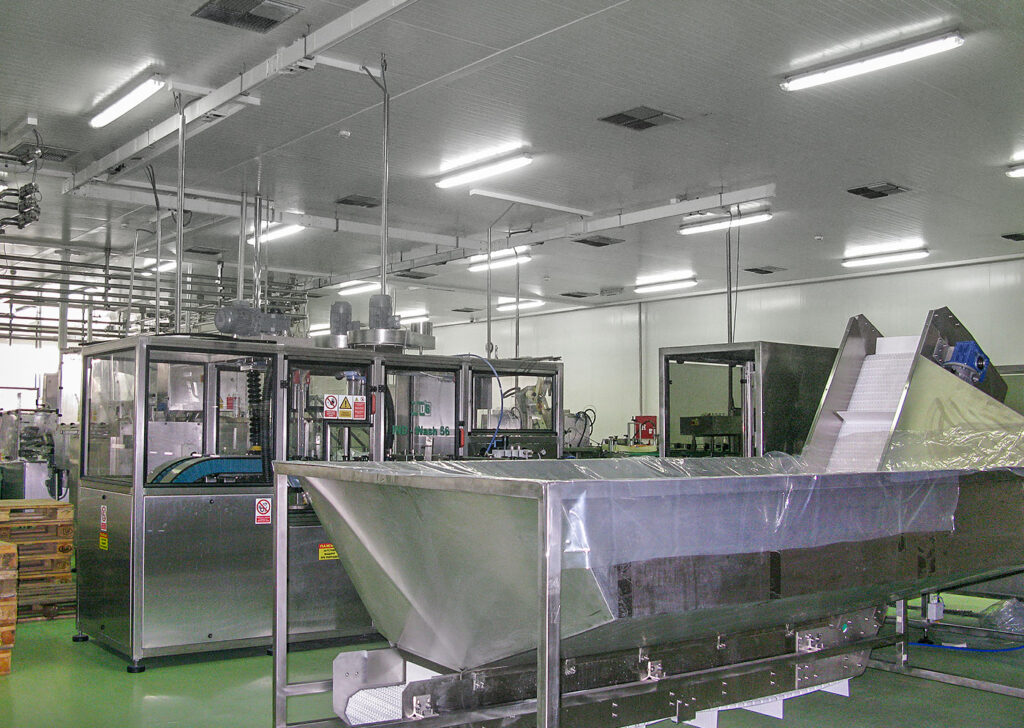
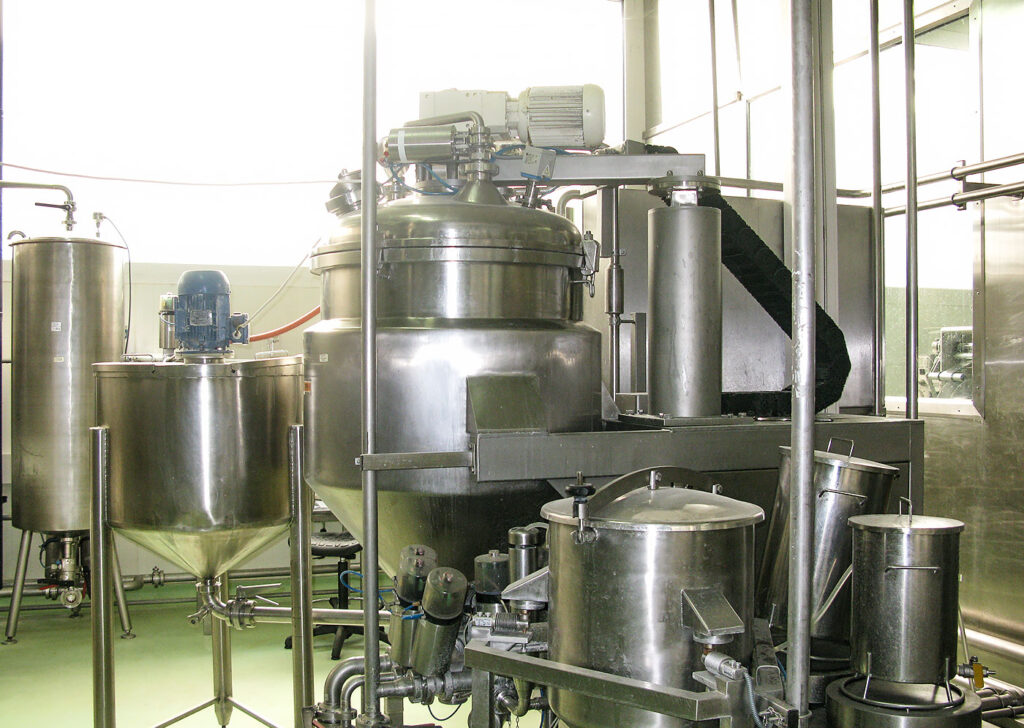
Yeast Extract Plant Control System, Biospringer
- Decentralized control system equipment and solution
- Maximum level of reliability and availability (24h / 7 days)
- Well-tuned process parameters
- Operation and maintenance convenience
- Done within 6 months
DCS Control System for the Continuous Cooking Mode, Sunoko Sugar Factory
- Decentralized Control System equipment and solution
- Maximum level of reliability and availability (24h / 7 days)
- Well-tuned process parameters
- Operation and maintenance convenience
- Significant production cost reduction
- Done within 1 month
Molasses Desugarisation Process Control System, Sunoko Sugar Factory
- molasses storage and dilution
- Filtration
- Chromatography (Chromatographic Separation)
- Evaporation
- Clean – In – Place (CIP))
- Decentralized Control System equipment and solution
- Maximum level of reliability and availability 24h/ 7
- Reducing overall sugar production costs, better utilization of waste material
- Well-tuned process parameters
- Operation and maintenance convenience
- Done within 6 months
Clean-in-Place Cistern Washing Control System, Heineken
- Fully CIP automated process
- Maximum level of reliability and availability
- Operation and maintenance convenience
Automatic mode involves the implementation of the production process defined by the parameters of the selected procedure.
Dryer Unit Monitoring System, Agreoseme, Subotica
- Supervision of parameters in the drying process
- Logging measurements for further analysis
- Availability for future extension of the system
Grain Dryer Control System, Victoria Oil
- Improved maintenance and adjustment of process parameters
- Maximum level of reliability and availability
- Very fast detection of errors in the system
- independent adjustment of speeds of the five conveyors in the drying plant and the pre-drying conveyor,
- control of conveyor slip,
- display of temperature and humidity values at 12 measuring points along the dryer,
- temperature regulation loop for burners,
- On/off operations for 37 drives, either each on its own or following a precisely defined sequence,
- visual inspection of each operational device,
- trouble shooting,
- recipes.
Selected References in
Mechatronics
We successfully accomplished over 160 projects which included automation of mechatronics.
WE PRESENT SOME OF OUR LARGEST PROJECTS BELOW
Aplication Software Development for the Duo HoReCa Napkin Production line, 9. Septembar
Mikro Kontrol developed a complete algorithm for control software based on function blocks, application software for safety controller, motion controller and HMI interface, and commissioning with performance test.
Benefits
- Very reliable, fast and modern control system based on the last generation Omron NJ Motion controller platform
- Safety protection integrated in safety controller and motion controller
- Parallel work of transport cars, controlled by the Omron servo drives, contributing to a very large line capacity
- Complete monitoring and parameter setting of the machine
- Established fast and efficient communication between all parts of production line
Technical Description
Standard parts of napkin production line include: paper unwinder, printing section, emboser section, longitudinal cutting and perforation, counting and packaging head, transporting part and part for transporting to the packaging machine.
To incerease the line capacity, Mikro Kontrol designed 4 production channels. On every channel, there are 2 pairs of transport cars, driven by 4 servo motors. Internal communication of transportation cars provide very fast and efficient transport without any possibility of collision and accidents.
In addition to many drives controlled by frequency converters, production line includes 24 servo axis capable of very quick and efficient task completion.
In order to avoid channel congestion and capacity decrease, the unloading part of the transport system intermittently moves packages from these 4 channels to an exit chanel on the packaging machine.
Automation of Dual Line Dental Bib Making Machine, 9. Septembar
Mikro Kontrol developed an application for automatic dental bib making machine for a new line of machines. The application is one in the long history of successful projects implemented for our long-term partner, 9. Septembar.
Scope of Work
Mikro Kontrol did the full automation project, which firstly included development of PLC and HMI applications, and later commissioning, testing and integration into the customer supervising system. During the trial operation Mikro Kontrol provided full support to our customer in order to achieve high machine performance.
Benefits
- High production capacity while maintaining top product quality
- Various products including printing or self-adhesive bibs
- Easy product changeover
- Maximum level of reliability and availability
- Operation and maintenance convenience
- Safety control system
- Integration into end customer supervising system
Technical Description
Each machine consists of two paper roll unwinders and two foil unwinders. Two unwinders reduce machine stop time due to material changing. Unwinders, lamination and embossing section of the machine are regulated with frequency inverters.
Encoders and photo sensors enable stable flow of material through the machine. High-speed controller and high speed EtherCAT communication enable precise application of adhesive on every dental bib. Perforation of the bibs according to given length as well as roll producing is done by servo motors.
Ethernet/IP communication between controllers coordinates work of the machine. Implemented controllers fully support OPC UA thus enabling the integration into the end customer supervising system.
Automation of HST Folder Gluer Machine, Opti-Run GmbH
For production of high speed/capacity cardboard machines Mikro Kontrol delivered a highly demanding mechatronics application.
Scope of Work
Mikro Kontrol delivered detailed and As-built electric design, electrical cabinets, servo motors and sensors, PLC and HMI application, commissioning and testing.
Benefits
- Upgraded machine capacity and speed
- High precision of band cutting and stamping
- Easy to operate and working parameters setting-up
- Minimum risk for the operator
- Integration into end customer supervising system
Technical Description
The machine consists of several applicator heads for gluing and band stamping the cardboard boxes on the fly. Each band stamping head consists of two servo motors for adding and cutting the silicon tape that is applied over hot melt glue. Hot melt is applied by the previous applicator consisting of high speed nozzle. Position of each cardboard in the machine is tracked by encoder.
High-speed control system was developed using modern motion controller with EtherCAT communication. A speed of 25 000 pcs/hour is achieved. Control system also includes safety controller. Along with safety devices such as emergency stop buttons and light curtians, control system ensures minimum risk for working enviroment and operator.
Supported by the OPC UA, controller is integrated into the end customer supervising system. Using cloud services machine performance, monitoring by the end user is facilitated.
Automation of RCP and URB Machines for Toilet Towels Rolls Packing, STAX Technologies
Mikro Kontrol has developed PLC and HMI applications for two types of toilet towels rolls packaging machines. RCP machine packs rolls in cardboard boxes, while the URB machine packs rolls in plastic bags. Both machines have a high level of complexity and each has more than 10 motion axes.
Scope of Work
Mikro Kontrol did the full automation, including development of PLC and HMI application, commissioning, testing and integration to user’s supervising system. During the trial period, Mikro Kontrol provided full support to the client to achieve the maximum machine performance.
Benefits
- High capacity with stable product quality
- Easy product changeover
- Working with recipes
- Easy operation and maintenance
- Safety control system
- Integration into end customer supervising system
Technical Description
Both machines consist of an entry conveyor and a diverter that arranges the rolls horizontally to form one row of rolls in the packet. The entire row comes to an elevator that goes down to accept a new row of rolls. The package formed on the URB machine is pushed to the plastic bag which is welded and cut, and then passes through a thermal tunnel. Unlike URB machines on the RCP machine package is inserted into a cardboard box that is previously formed on a separate section of the machine. The box then closes with duct tape on both sides.
Multi-axis high speed controller with Ethernet CIP communication is used for the implementation of the control system. All movements are carried out through CAM profiles to achieve the maximum speed of the machine with minimal mechanical load.
Through Ethernet Data Link Communication, the connection to other controllers in the plant has been achieved and the integration to the user’s supervising system has been provided.
Control System for Vertical and Horizontal Bronze Profiles Casting Machines, SIA KMM METAL, Latvia
Mikro Kontrol provided control system for 6 casting machines for solid and hollow profiles of bronze for the Latvian company SIA KMM METALS.
Scope of Work
Mikro Kontrol provided detailed and As-built electrical design, low voltage and control cabinets delivery, application software, commissioning, trial operation and training.
Benefits
- Technology monitoring with corrections during casting, without stopping the machine
- Knowledge database for specific cast profile with recommended casting parameters (step, pause)
- Enabled data archiving for casting 24/7 (selected profile, casting speed, temperature, quantity of cast profile in kilograms)
Technical Description
This type of casting machines has been using hydraulic mechanism for pulling with traction rollers. Hydraulic unit is replaced with an AC servo motors with a brake. In addition to the motor operation control, the system includes:
- Temperature measurement in the casting pot and the operating control for the burner that warms up the casting pot with fuel flow measurement
- Crystallizer water flow and temperature measurement (input – output)
- Surface temperature measurement of cast profile
The maximum outside diameter of profile being cast is 65 mm, the minimal wall thickness of hollow profiles is 3.5 mm.
Selected References in
Other industries
We successfully accomplished many automation projects in other industries such as Cranes, Rubber Industry, Mechatronics, HVAC …
WE PRESENT SOME OF OUR LARGEST PROJECTS BELOW
Modernization of Two Gantry Cranes 160/50 t, HE PP Djerdap
Mikro Kontrol did a full reconstruction and modernization of two gantry cranes, capacity of 160/50t to support hydro-mechanical equipment in individual work as well as in coupled work.
- Reliable work in both single and coupled mode
- No portal corruption
- The supervision and control of the load amount of each hook
- Safety circuit implemented
- Monitoring alarm system
- The speed limit in relation to the position and load management driving portal in terms of drive synchronization on both sides
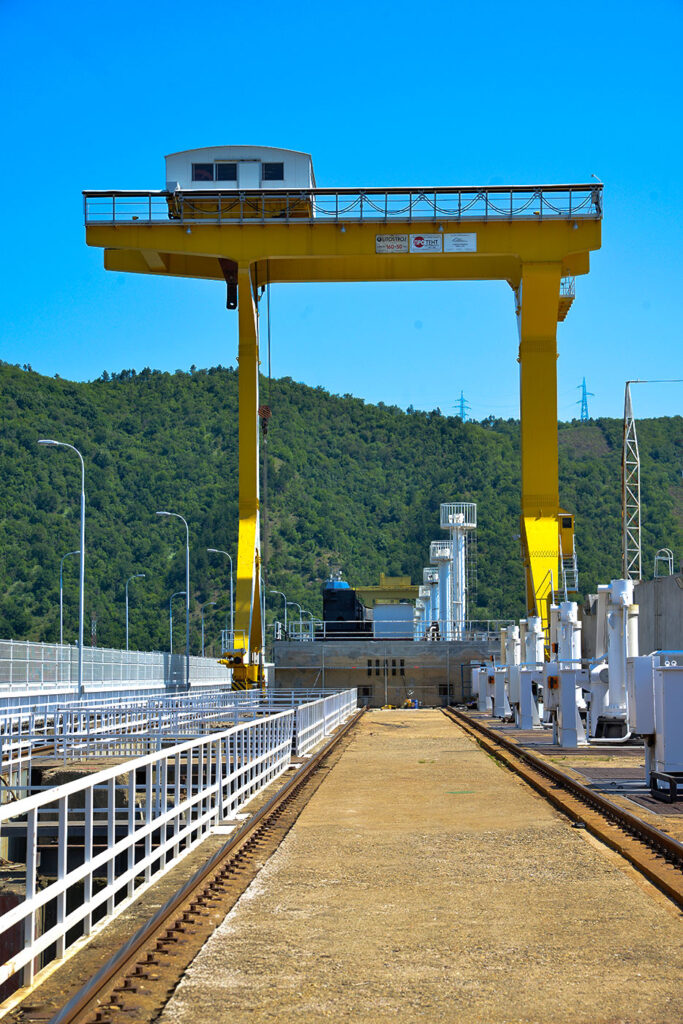
Rubber Mixer Control System Modernization, Trayal doo
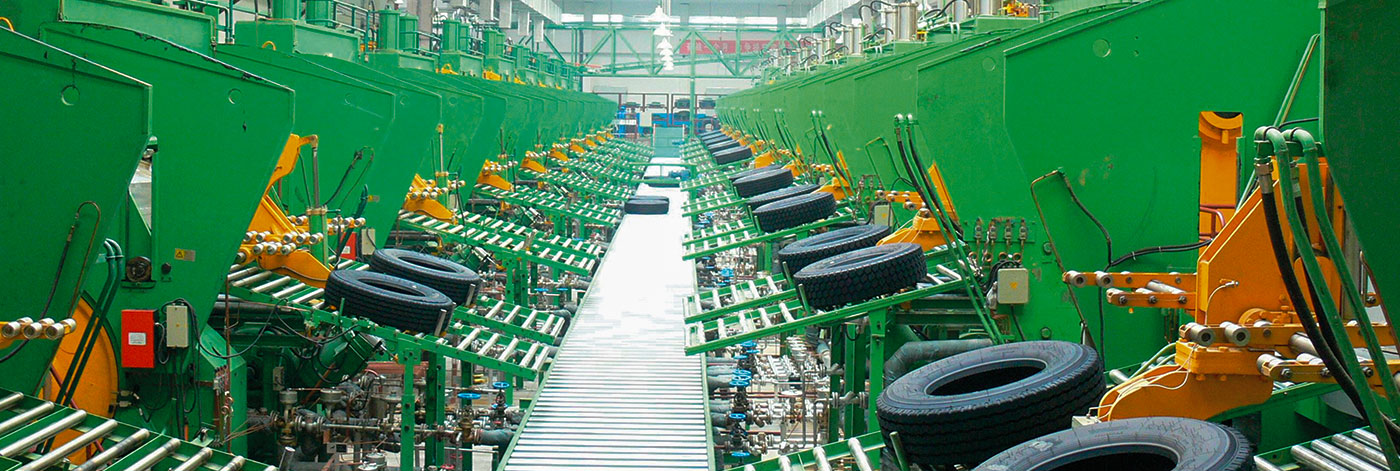
After more than 10 years of problems with support and maintenance of the original Chronos Richardson control system, with obsolete equipment and frequent interruptions in the production, the customer obtained a reliable and modern technical solution, based on PLC control network and SCADA/batch processing of the information reception.
The technology recipe combines 6 components (2 liquids – waxes and oils, and 4 solids – polymers and additives, soot, ZnO, white powders) in weighing / mixing process which produces semi-product for heavy-vehicle tire manufacturing.
Scope of Work
Mikro Kontrol provided detailed and as-built design, control panel manufacturing, application software, parametrization of weighing scales, testing and commissioning.
Benefits
- The customer obtained a reliable and modern technical solution
- The production stoppage needed for the equipment replacement lasted for only 5 days
- Well-tuned process parameters
- Operation and maintenance convenience
- The whole project finished within 2 months
Technical Description
The control system includes two technology units: weighing system and mixing system.
The control system is done through a multi-master PLC network, where one controller (operator room) controls all process sequences (batch control – weighing and mixer sequences by means of recipe generated in SCADA), and other controller is located near weigh belt / mixer inlet door location controls each particular weighing (load cells connected to their measuring modules).
In addition to SCADA which is installed in operator room, with separate database batch – processing module for recipe generation and monitoring (developed by Mikro Kontrol), there is a HMI located near weigh belt, where operator can monitor the actual weighing of each component, as well as the actual information reception and history.
